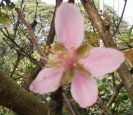Decoration Types of Chinese Porcelain
Basic Decoration Types
The following are the two main styles used in decorating porcelain.
On-glaze decoration (釉上彩)
- On-glaze decoration is hardly affected chemically by the glaze
- The color remains the same
- The decoration is relatively easily worn or scratched
- After applying the decoration the item is low-fired at 700 - 900 degrees Celsius.
Underglaze decoration (釉下彩)
- Decoration is painted on the raw body,then the glaze is applied and all is fired at once
- The colors are retained over a very longtime.
- Some of the earliest decoration types:
underglaze blue, underglaze red, underglaze sancai (tri-color)
................................................................................
Decoration Types
Underglaze blue & red (青花, 釉裡紅)
These are the earliest painted color decoration found on porcelain. Underglaze blue and red decorations were developed largely during the Yuan dynasty (1206~1367). Blue and white became the favorite decoration of the time.
Doucai (鬥彩)
Developed in the Ming dynasty, this polychrome decoration was already valuable right from the start. With Doucai the contours (only) are drawn in underglaze blue, the colors are the filled in these outlines on top of the glaze.
Susancai (素三彩 literally: raw three colors)
The best translation
for “Susancai” would be “plain three-colored”. Don't be
confused by the “sancai” term. Yes, it means the same as with
“Tang Sancai”, “Liao Sancai” its more famous predecessors
from the Tang and Liao dynasties. (See dynasty table in appendix.)
However,
the latter two were not painted decorations 'per se', they were
decorations obtained by either pouring color glazes over areas of an
item, or by adding simple dots,etc.
Kangxi Susancai
Kangxi Susancai
decorations were the result of development that was going on since
the Ming dynasty. Susancai decorations were at a peak during the Kangxi period, when they became a full-featured polychrome decoration painted in
elaborate detail. Despite its (plain) name, a Susancai decoration of the Kangxi reign can contain complicated floral decorations, dragons, etc.
Actually, the term 'plain' does not apply to the
decoration itself but rather to the colors used - these were limited to various hues of green, brown
and yellow (and the occasional blue) as the predominant colors on a
black, yellow or white ground. There is no red in this type of decoration.
Fencai (粉彩)
This on-glaze enamel decoration was also one of the decoration types that appeared first in the late Kangxi reign.
It is also called 'soft colors' (軟彩) in Chinese
Fencai allows better control of color intensity (darker/lighter), enabling the creation of different color depths.
After its appearance Fencai quickly replaced Wucai and other polychrome decorations, becoming the mainstream color decoration.
- The decoration was painted on the white fired body.
- Glass powder was added to the pigments.
- The decoration was fired twice at 720 -750 degrees C.
Enamel decoration or Falangcai (琺琅彩)
This is an on-glaze enamel decoration first fired in the late Kangxi reign.
The
craftsmen at Jingdezhen kiln used originally enamels on a
copper, brass or glass base, only that this one now was applied on a
porcelain base. A new decoration type was created.
The white body was fired at Jingdezhen, then it was transported to the palace, where it was painted and fired twice in the internal workshops.
(Only a limited number of items (300 plus only) were actually produced. They are virtually all imperial ware.)
Yangcai (洋彩)
Yangcai is a type of on-glaze decoration used in the Qianlong reign.
Contemporary
court records classify Yangcai as a type of enameled porcelain. The
polychrome decoration was painted on white porcelain using western
painting techniques.
Falangcai was also called Yangcai, initially, when it was introduced into China. (Yang means "western, foreign " in Chinese)
Yangcai Overview of National Palace Museum, Taiwan (Yang-ts'ai = old spelling of Yangcai)
|
The Yangcai or Falangcai decorations were originally intended for the palace only. At times, the imperial palacewas very secretive about the materials and methods employed for making imperial porcelain wares. |
 |
Gilt decoration (金彩)
A type of on-glaze decoration.
The decoration is added to an already fired body, then another firing is done at a lower temperature.
Wucai (五彩)
Other Chinese names: 古彩,硬彩
Its mineral pigments are based on metals.
The meaning of “wucai” is "five colors". Wucai decorations were developed during the Ming dynasty.
With
this type of polychrome decoration, commonly the blue color is under
the glaze, the other colors are painted on top of the glaze. First the
blue part of a decoration is painted on the porcelain
body which is then glazed and then fired. After that the other colors
are
painted on top of the glaze and a second firing is performed.
However, there do also exist wucai decorations where all colors are painted on top of the glaze.
Wucai decorations were
one of the predominant polychrome decorations during the Ming dynasty. With
the introduction of Fencai decorations during the Kangxi reign of the
Qing dynasty, the importance of Wucai decorations decreased, however, although
items with this decoration type continued to be produced.
One of the
characteristics of wucai decorations is that its colors are fairly
bright (strong), without the ability of differentiating the color
tone in order to obtain lighter hues of the same color.
The application of lighter or darker shaed
is possible with Fencai decorations introduced in the Kangxi reign. This is possibly one of the
reasons that lead to a decline of Wucai decorations and the increased popularity
of fencai porcelain in 18th century China.
Qianjiang (淺絳彩)
Qianjiang decorations developed during the mid-19th century, in the Xianfeng reign. Relatively few were made thereafter until the late Tongzhi reign (1862-1874), when this decoration style gained popularity. Most of the classical Qianjiang porcelain items appear to have been made in the Guangxu reign, when they were most common.
See Qianjiang porcelain.
